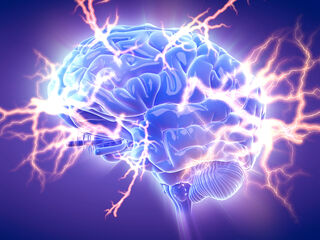Neuroplasticity
Create Your Reality Without Pain: Neuroplasticity
Focusing on a vision of being pain-free can break you free.
Posted July 10, 2021 Reviewed by Vanessa Lancaster
Key points
- Chronic pain is a neurological problem and interventions directed at structural causes alone can't and don’t work.
- Stimulating neuroplasticity, the brain's ability to adapt, is a core tool in solving chronic pain.
- It is possible to rewire the brain around almost any set of pain circuits regardless of the source and how long a person has suffered.
Your brain physically decreases in size when you are suffering from chronic pain.1 Historically, scientists thought a person was born with a certain number of brain cells and slowly lost them over a lifetime. Although brain activity is at its highest intensity for the first few years of life, recent studies have clearly shown that the brain can change at any age—for better or worse.
Understanding Neuroplasticity
Neuroplasticity is the term that refers to the ability of the brain to adapt, and it develops wherever you place your attention. It’s your choice whether you want to direct it in a positive or negative direction. Several of the ways that changes occur are:
- Growth of new nerve cells (neurons)
- Shrinking of neurons from disuse
- Increasing or decreasing the number of connections per neuron
- Laying down or losing layers of insulation called myelin (this layer improves the speed of nerve conduction)
- Substitution of an injured part of the brain with another area, where the new region takes over and compensates for the deficits. For example, when a person loses sight, the brain's hearing and feeling/touch centers become more active.
The bottom line is that your brain is in a dynamic state of change every millisecond, depending on how much it is stimulated—or not.

There is an incredible upside potential because the nervous system has a large capacity to change positively if it is kept active and creative.
The dark side is that when your brain shrinks or atrophies, such as when you are suffering from chronic pain, you are less able to act rationally to pull yourself out of the hole. This is still a solvable problem with help and the right tools.
Stimulating neuroplasticity in your nervous system is one of the core strategies for solving chronic pain. The other is learning to regulate your physiology from threat to safety.
My Brain Is Shrinking?
Why would your brain shrink in the presence of chronic pain? When your nervous system gets stuck on repetitive thought and pain patterns, they grow into monstrous circuits, and less time is spent on forming creative connections. The brain areas that enjoy good friends, music, art, wine, and life gradually shrink with disuse. There is a vast amount of neural activity involved with these endeavors that don’t happen in the presence of unrelenting pain.2
What is also problematic is that when you are stressed, your immune system fires up, and small communicating proteins (cytokines) are stimulated that are inflammatory. The brain's supporting cells (glial cells) produce these cytokines, and the brain itself becomes inflamed and sensitized. This destroys neurons. The blood supply to the thinking areas of the brain (neocortex) shifts to the survival regions lower in the brain, making it harder to think clearly.
Memorized Circuits
An additional factor is that these disruptive circuits are memorized. Once you know how to ride a bicycle or walk, you cannot unlearn the skill. Similarly, pain circuits that are laid down in your brain become permanent within six to twelve months.3 Suppressing frustration and anxiety that is inevitably associated with being in pain reinforces these unpleasant circuits even more and also damages your hippocampus that is the memory center of your brain.4
What Is the Solution?
Quit reinforcing pain circuits. You must lay down alternate circuits or detours around existing problematic ones. Similar to learning a new language or any high-level skill, repetition is vital. The other outcome from stimulating neuroplasticity in a positive direction is that your nervous system becomes less reactive and calmer. You can process more stress before your body sends out danger signals and creates a flight or fight response. The sequence is awareness of what you are feeling, creating some “space,” directing your attention to what you want – not to what you are trying to fix.
It is remarkable how quickly your mood and pain can improve. Shifting to pre-existing enjoyable circuits is even a faster solution. This causes a marked improvement in your body’s physiology from threat to safety.
The good news is that when you successfully treat chronic pain, your brain re-expands,5inflammation, and hypersensitivity improve, and the perception of pain diminishes.
What Is Possible
I am convinced you can rewire your nervous system around almost any set of chronic pain circuits – even if the source is an identifiable anatomic abnormality. The stories continue to border on unbelievable. Some stories of healing include:
- A woman with 55 years of widespread pain
- A gentleman with 22 years of pain, a suicide attempt, on high doses of opioids, and underwent 28 surgeries
- A middle-aged woman with over ten years of abdominal pain and headaches
- A young woman who suffered for four years with severe neck pain, saw over ten doctors, was on high-dose narcotics, and had six neck injections
One metaphor is that of creating or installing a virtual desktop on your computer. The other one is still there, it is not being used as much, and the new set of circuits are less painful. Stimulating neuroplastic changes in your nervous system does not seem to have a limit as to how far you can take it, and patients often thrive at a level that they never knew was possible.

Recap
Your brain and the rest of your nervous system is one dynamic organ that immediately responds to sensory input. Modern neuroscience has demonstrated the neuroplastic nature of the brain. You have a choice of what sensory input you choose to program it with.
References
1. Apkarian AV, Sosa Y, Sonty S. Chronic Back Pain is associated with decreased prefrontal and thalamic gray matter density. Journal of Neuroscience 2004; 24: 10410 -10415.
2. Dragananski, et al. Temporal and spatial dynamics of brain structure changes during extensive learning. The Journal of Neuroscience 2006; 26: 6314-6317.
3. Hashmi, JA, et al. Shape shifting pain: chronification of back pain shifts brain representation from nociceptive to emotional circuits. Brain (2013); 136: 2751–2768.
4. Hulbert JC, et al. Inducing amnesia through systemic suppression. Nature Communications (2015); 7:1103. doi: 10.1038ncomms1103
5. Seminowicz DA, et al. Effective treatment of chronic low back pain in humans reverses abnormal brain anatomy and function. The Journal of Neuroscience (2011); 31: 7540-7550.



